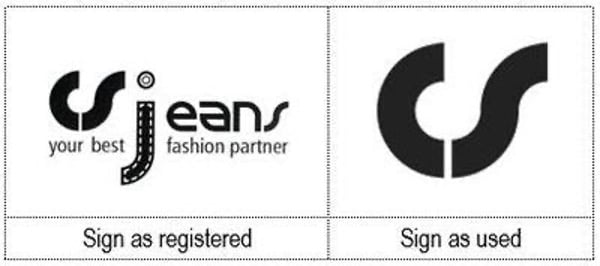
The Board of Appeal recently arrived at the decision to revoke an EU trade mark owned by CS Jeans. The rationale for this was born out of the fact that the owner of the registered trade mark used arguably a different trade mark and used it on terms that were different from what was covered in the registration. The Board of Appeal held that the registered proprietor used a mark which omitted multiple elements of the original applied-for trade mark and also that the owner of the registration used it for different goods and services than were originally stipulated in their application. This article will accordingly underline the importance of consistency between the registration of a trade mark and the use thereafter by exploring the pertinent issues of this case and further detailing how the Board of Appeal arrived at their decision.
The trade mark in question was owned by CS Jeans, and was the following figurative mark:

As any casual observer can see, there are differences between the appearance of the trade mark as registered as compared with the mark as used. Even just a cursory glance shows the absence of all words used in the registered trade mark and, arguably most importantly, the absence of the ‘j’ in the word ‘jeans’ which has been significantly stylised. This was a major factor that the Board of Appeal took issue with. This is because, it was explained, the letters ‘j’ and ‘s’ in the word ‘jeans’ were significantly stylised so as to give the overall mark a sufficiently distinctive character. However, without these elements, as per the sign as used, the mark now simply reads as ‘CS’, and the overall distinctive character of the mark has therefore changed. The Board of Consumer held that it was not necessarily the case that a consumer would perceive the figurative element ‘CS’ as being the dominant part of the mark or that the element ‘jeans’ was negligible. On that basis, the owner of the mark had only used the mark in altered form.
The difference in appearance of the trade mark was not the only reason the Board of Appeal decided to revoke the registration. Another important factor in arriving at their decision was the fact that the owner of the trade mark also used this trade mark in respect of different goods and services than what the trade mark was originally registered for. The owner had applied for this trade mark in relation to clothing, footwear and headgear in Class 25. The evidence on record showed that they actually went on to use this trade mark for clothing manufacturing services. The reason that this is so pertinent to the matter at hand is the requirement is laid out in in Article 18(1) and 58(1)(a) of the EU Trade Mark Regulations (EUTMR) that a mark can only be considered to be in genuine use if it is being used ‘in respect of which [the goods and services] it is registered’. Furthermore, use of a trade mark in respect of goods and services similar to what it was registered for does not constitute genuine use under Article 8(5) EUTMR. As the owner of this trade mark did not use it for goods and services to what was covered by the trade mark registration, the Board of Appeal found further grounds for revocation of this trade mark.
What this case underlines, therefore, is the importance in consistency between trade mark registration and trade mark use. This applies not only in terms of the appearance of the mark (or in the case of word marks, the specific wording and/or spelling) but also in terms of the goods and services the owner is using the trade mark on. On the latter point, if the owner has not quite committed to a particular product or service, they could consider, at the outset, a border specification list. The owner is still able to pare down their application and eventual registration should there be a need in the future. However, a trade mark owner is unable to expand on the goods and services of a mark once it has been filed, and the only way to do this would be to file a separate application.
Send us your thoughts:
Would you like to read more articles like this?
Building 1000
Cambridge Research Park
CB25 9PD
Fax. 01223 425258
info@iamstobbs.com
Privacy policy
German office legal notice
Cookie Declaration
Complaints Policy
Copyright © 2022 Stobbs IP
Registered Office: Building 1000, Cambridge Research Park, Cambridge, CB25 9PD.
VAT Number 155 4670 01.
Stobbs (IP) Limited and its directors and employees who are registered UK trade mark attorneys are regulated by IPReg www.ipreg.org.uk

